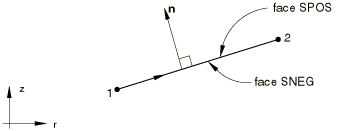Typical Applications
Surface elements are useful in several special modeling cases:
-
They are used to carry rebar layers to represent thin stiffening components in solid structures. The stiffness and mass of the rebar layers are added to the surface elements (see Defining Reinforcement). The reinforced surface elements can also be embedded in “host” solid elements (see Embedded Elements).
-
They are used to bring additional mass into the model in the form of a mass per unit area; for example, to spread the mass of fuel in a tank over the tank surface, particularly when the tank is modeled with solid elements.
-
They are used to specify a surface used in a constraint, when that surface does not have structural properties.
-
When used in conjunction with a surface-based tie constraint, they are used to specify distributed surface loading, such as incident wave loading, on beam elements.
-
In Abaqus/Explicit (when used in conjunction with a surface-based tie constraint) they can be used to specify a complex surface on beam elements for use in general contact. The stiffness of the penalty springs used to enforce contact constraints is approximately proportional to the mass of the surface nodes. Contact will not be enforced if the surface nodes have no mass.
-
In Abaqus/Explicit they can be used to define all or part of the boundary for a surface-based fluid cavity (for example, see Hydrostatic fluid elements: modeling an airspring).
-
In Abaqus/Aqua analysis they can be used to visualize gravity waves.





